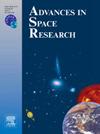Coupling of downscaled GRACE data with SPHY derived hydrological components to generate snow water equivalent in the Himalayan catchment
IF 2.8
3区 地球科学
Q2 ASTRONOMY & ASTROPHYSICS
引用次数: 0
Abstract
This study demonstrated the applicability of Gravity Recovery and Climate Experiment (GRACE) satellite data through the coupling of multisource datasets in cryospheric and hydrological assessments over the Himalayan basin. For this purpose, a coupled modeling framework was developed using the fully distributed Spatial Process in Hydrology (SPHY) model, forced by real-time satellite and hydro-observation datasets. To reduce uncertainty in the outcomes, a two-step calibration approach was performed: (i) utilizing the observed discharge at two gauges, namely Maneri and Rishikesh, and (ii) comparing the MODIS-derived snow cover area (SCA) with the SPHY-derived SCA. The observed versus modeled discharge was found to be comparable, with the corresponding coefficient of determination (R2) recorded as 0.64 and 0.66 for Maneri and Rishikesh, respectively. The seasonal snow cover computed by SPHY was validated against MODIS snow cover maps, yielding a coefficient of determination of 0.73 (2015). By analyzing the snow mass loading and unloading using GRACE Total Water Storage Anomalies (TWSA) and MODIS snow cover data, sixteen snow seasons (between 2002 and 2020) were identified in the snow-glacier-dominated sub-basins of the Upper Ganga River. The snow water equivalent (SWE) was computed after subtracting other hydrological/water-balance components in these sub-basins. A spatial downscaling of GRACE TWSA was performed utilizing the GLDAS variables, showing significant improvement in the GRACE TWSA at a 0.25° × 0.25° scale. The correlation analysis showed a good match between GRACE and GLDAS variables (R2 up to ∼0.7). The downscaled GRACE-TWSA was compared with SPHY-TWSA and other cryospheric-hydrological components at different stations, with results found to be comparable. The results show that GRACE + SPHY SWE is comparable to GLDAS SWE in upstream regions, though some discrepancies exist downstream. For establishing the relationship between GRACE TWSA and hydrological components, cryosphere and hydrology variables such as snowmelt runoff, glacier melt runoff, baseflow, and rainfall-runoff were successfully separated at different stations (or sub-basins).
将缩小比例的GRACE数据与SPHY衍生水文分量耦合以生成喜马拉雅流域的雪水当量
通过多源数据集的耦合,验证了GRACE (Gravity Recovery and Climate Experiment)卫星数据在喜马拉雅盆地冰冻圈水文评估中的适用性。为此,在实时卫星和水文观测数据集的强制下,利用全分布式水文空间过程(SPHY)模型开发了一个耦合建模框架。为了减少结果的不确定性,采用了两步校准方法:(i)利用Maneri和Rishikesh两个测量点的观测流量,以及(ii)将modis导出的积雪面积(SCA)与sphy导出的SCA进行比较。观察到的流量与模拟的流量具有可比性,Maneri和Rishikesh的相应决定系数(R2)分别为0.64和0.66。SPHY计算的季节积雪覆盖与MODIS积雪覆盖图进行了验证,确定系数为0.73(2015)。利用GRACE总蓄水异常(TWSA)和MODIS积雪覆盖数据,分析了恒河上游冰川为主的子流域2002 ~ 2020年的16个雪季。在减去这些子流域的其他水文/水平衡分量后计算雪水当量(SWE)。利用GLDAS变量对GRACE TWSA进行空间降尺度,在0.25°× 0.25°尺度下GRACE TWSA有显著改善。相关分析显示GRACE和GLDAS变量之间匹配良好(R2高达~ 0.7)。将缩小后的GRACE-TWSA与SPHY-TWSA和不同站点的其他冰冻圈水文成分进行了比较,结果具有可比性。结果表明,GRACE + SPHY SWE在上游地区与GLDAS SWE相当,但下游地区存在差异。为了建立GRACE TWSA与水文分量的关系,成功分离了不同站点(或子流域)的冰雪融水径流、冰川融水径流、基流和降雨径流等冰冻圈和水文变量。
本文章由计算机程序翻译,如有差异,请以英文原文为准。
求助全文
约1分钟内获得全文
求助全文
来源期刊

Advances in Space Research
地学天文-地球科学综合
CiteScore
5.20
自引率
11.50%
发文量
800
审稿时长
5.8 months
期刊介绍:
The COSPAR publication Advances in Space Research (ASR) is an open journal covering all areas of space research including: space studies of the Earth''s surface, meteorology, climate, the Earth-Moon system, planets and small bodies of the solar system, upper atmospheres, ionospheres and magnetospheres of the Earth and planets including reference atmospheres, space plasmas in the solar system, astrophysics from space, materials sciences in space, fundamental physics in space, space debris, space weather, Earth observations of space phenomena, etc.
NB: Please note that manuscripts related to life sciences as related to space are no more accepted for submission to Advances in Space Research. Such manuscripts should now be submitted to the new COSPAR Journal Life Sciences in Space Research (LSSR).
All submissions are reviewed by two scientists in the field. COSPAR is an interdisciplinary scientific organization concerned with the progress of space research on an international scale. Operating under the rules of ICSU, COSPAR ignores political considerations and considers all questions solely from the scientific viewpoint.
 求助内容:
求助内容: 应助结果提醒方式:
应助结果提醒方式:


